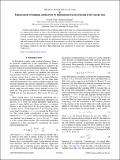Enhancement of hopping conductivity by spontaneous fractal ordering of low-energy sites
Author(s)
Chen, Tianran; Skinner, Brian J
DownloadPhysRevB.94.085146.pdf (923.1Kb)
PUBLISHER_POLICY
Publisher Policy
Article is made available in accordance with the publisher's policy and may be subject to US copyright law. Please refer to the publisher's site for terms of use.
Terms of use
Metadata
Show full item recordAbstract
Variable-range hopping conductivity has long been understood in terms of a canonical prescription for relating the single-particle density of states to the temperature-dependent conductivity. Here we demonstrate that this prescription breaks down in situations where a large and long-ranged random potential develops. In particular, we examine a canonical model of a completely compensated semiconductor, and we show that at low temperatures hopping proceeds along self-organized, low-dimensional subspaces having fractal dimension d = 2. We derive and study numerically the spatial structure of these subspaces, as well as the conductivity and density of states that result from them. One of our prominent findings is that fractal ordering of low energy sites greatly enhances the hopping conductivity and allows Efros-Shklovskii type conductivity to persist up to unexpectedly high temperatures.
Date issued
2016-08Department
Massachusetts Institute of Technology. Research Laboratory of ElectronicsJournal
Physical Review B
Publisher
American Physical Society
Citation
Chen, Tianran, and Brian Skinner. “Enhancement of Hopping Conductivity by Spontaneous Fractal Ordering of Low-Energy Sites.” Physical Review B 94.8 (2016): n. pag. © 2016 American Physical Society
Version: Final published version
ISSN
2469-9950
2469-9969